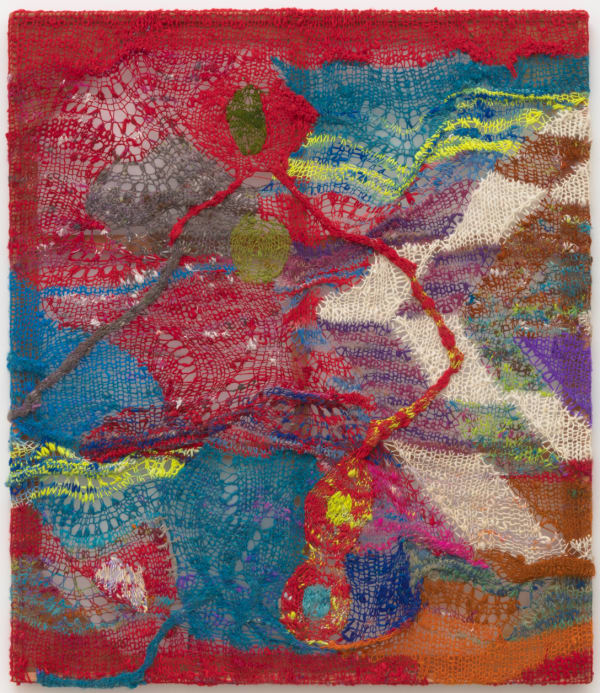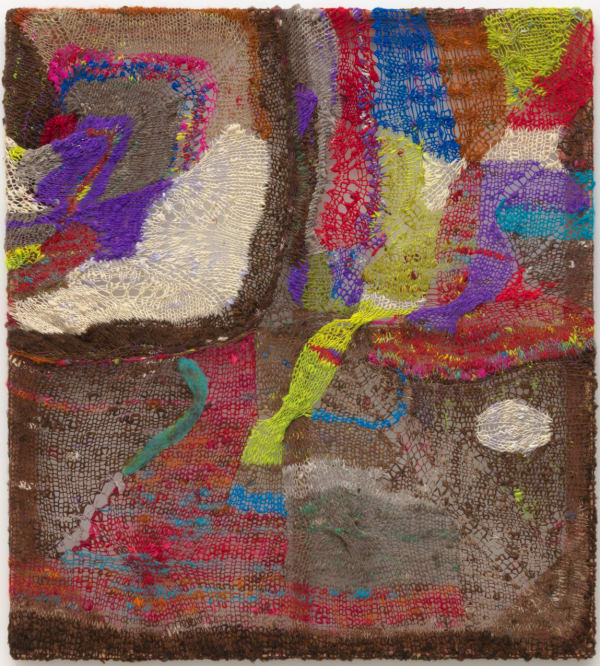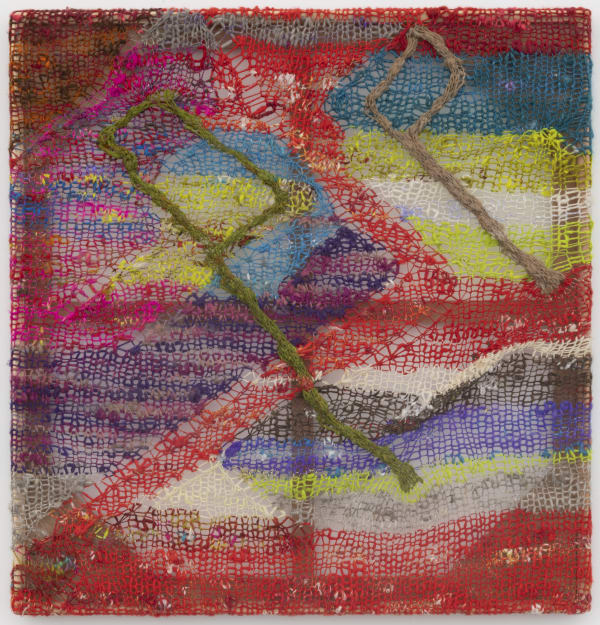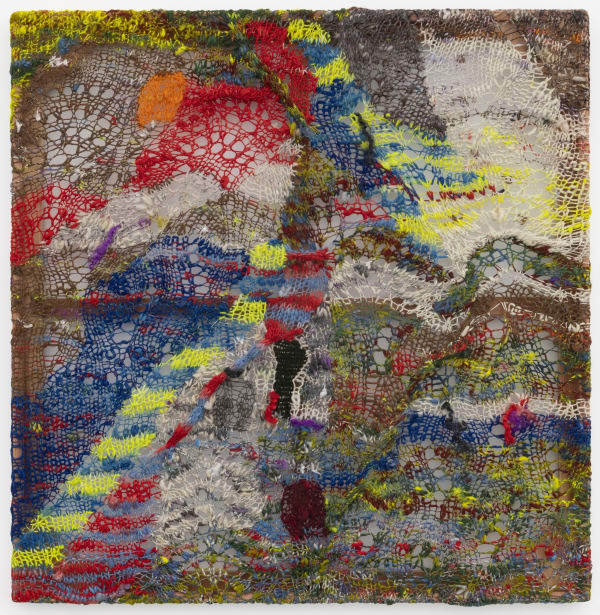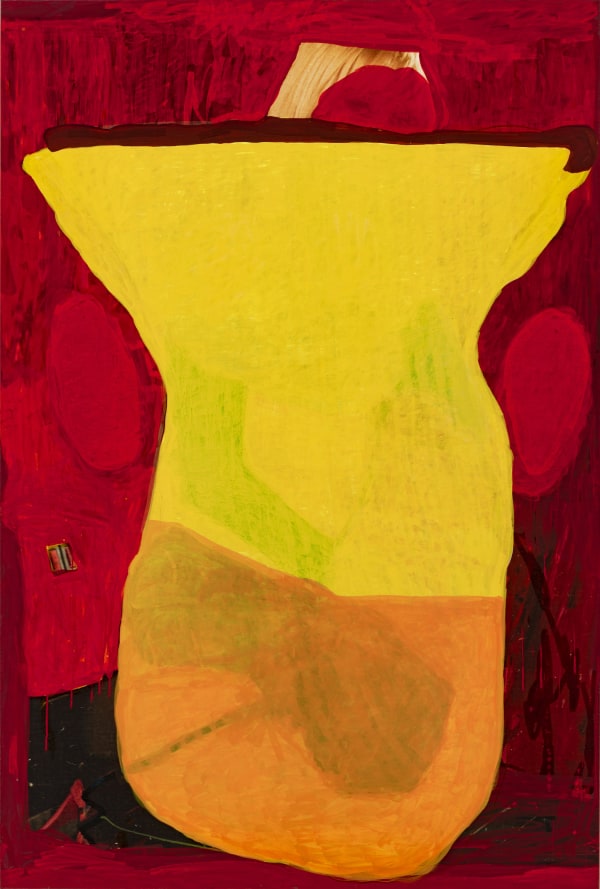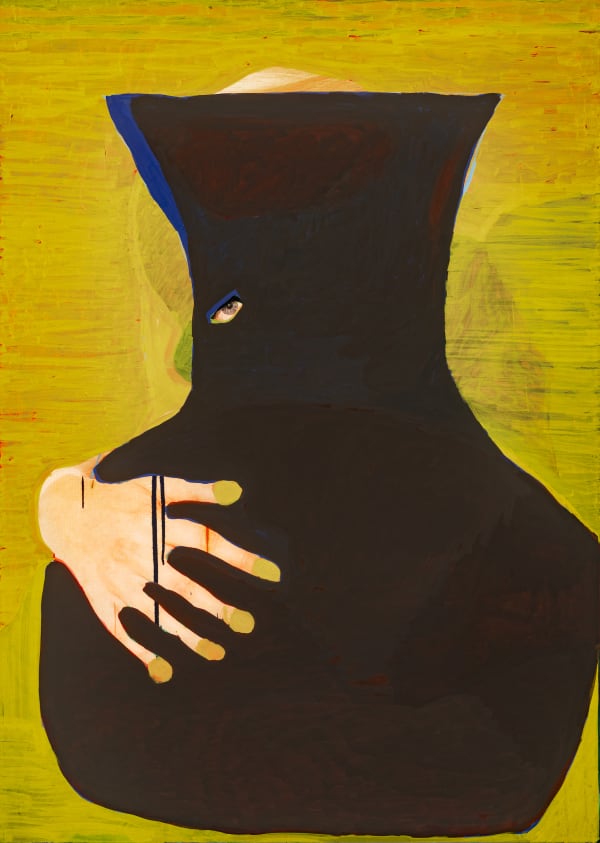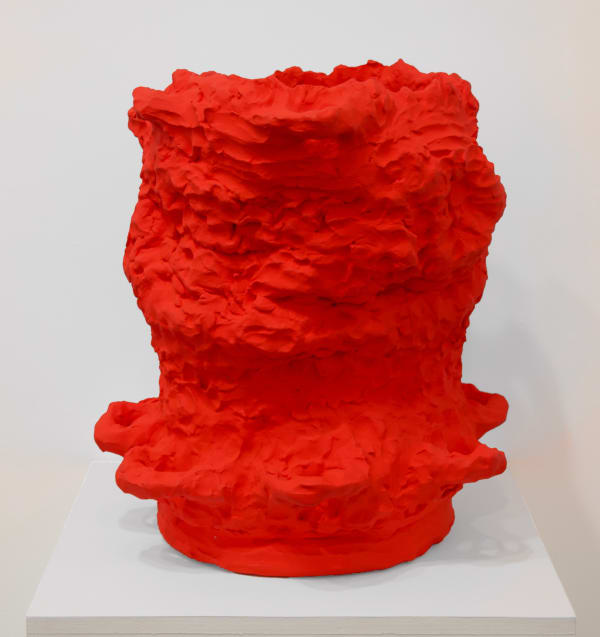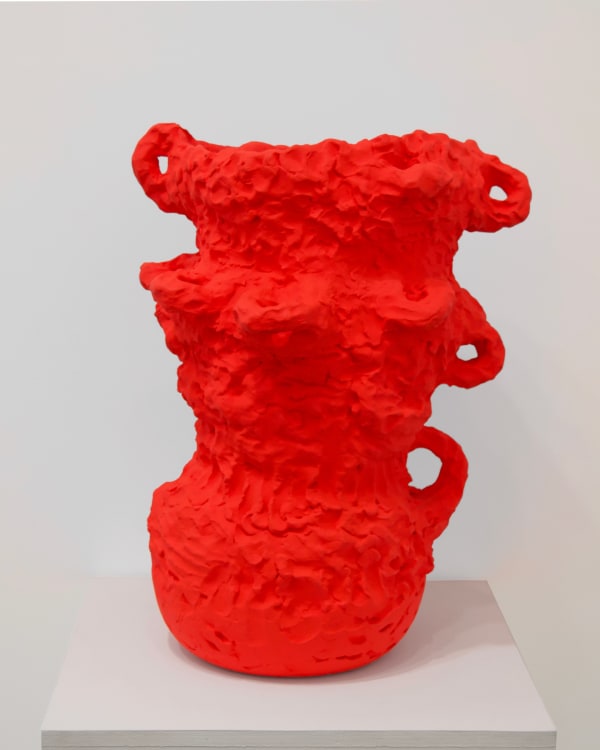-
HANSEN | HASSINGER | SEMMES
Dallas Art Fair 21 - 24 April 2022 -

CHANNING HANSEN, Defined Divergent, 2020
-
-
CHANNING HANSEN
Anticipatory Synthetic | Assume Emphasis | Continuity Fabric | Defined DivergentAn artist with inherited Fluxus leanings (Al Hansen is the artist's Grandfather), Channing Hansen relies upon chance in the creation of his work. Introduced to knitting in 2009, Hansen drew upon his work as a computer programmer to develop Algorithms that would dictate the materials and composition of his textiles. Using organic materials, primarily wool gathered from conservation-breed sheep, the artist dyes, spins, and hand-knits his work based on patterns determined by the computer.
Anticipatory Synthetic, Assume Emphasis, Continuity Fabric, and Defined Divergent are works from a new series that represents Channing Hansen's most direct engagement with AI to date. In this case, rather than build an algorithm using an external data set, Hansen hired a data scientist to write an AI machine learning program using his past work as the data set. The dimensions, patterns, colors, and even titles of previous Channing Hansen artworks were fed into the program, which then generated a set of instructions to create “a Channing Hansen artwork”—or, at least, what the AI thought a Channing Hansen should be.
-
CHANNING HANSEN
EasleyChanning Hansen's Easley is part of a series commemorating women's oft-overlooked contributions to the sciences. As the artist himself explained, "The idea [...] came to me after noticing how many people had unconsciously (or deliberately) gendered the medium of textiles as female. Science is (still!) rather absurdly gendered as male and its history is rife with examples of women whose contributions have been rendered invisible or were credited to male colleagues. This was my way of honoring them in the realm of art in a way that perhaps they had not been in their own field." The titles of these pieces pay tribute to female aerospace engineers of color who made significant contributions to the field through their work with NASA. Annie Easley led a team that generated software for the Centaur rockets.
Hansen's work was seen recently in Dallas in "Fresh Faces from The Rachofsky Collection,” at Site 131, Dallas.
-

Installation view, Channing Hansen (Left) in "Fresh Faces from the Rachofsky Collection" at Site 131, Dallas, Texas 2021.
-
The intersection between weaving and science has a long history, one that dates back to Charles Babbage’s nineteenth-century analytical engine (and to Ada Lovelace’s early algorithms for it), which was based on his observations of jacquard looms, the first partially automated weaving machines ... Hansen is the latest in such a lineage, and his constructions are at once marvels of handwork and invitations to contemplate our world from another point of view.
— Andy Campbell, Artforum
-

Maren Hassinger, Splintering, 2019
-
MAREN HASSINGER
SplinteringWire rope has long held a prominent role in Maren Hassinger’s artistic practice. As a sculptor placed in the Fiber Arts program at UCLA in the early seventies, Hassinger bridged the gap between the two media with wire rope. Binding nature with industry, the artist takes a biomimetic approach to the material, whether weaving strands of rope into a monolithic vessel or unraveling it to form skeins of unnatural fiber. In the case of Splintering, the artist utilizes the latter strategy, bundling the wire rope to resemble a sheaf of wheat or rustic broom.
Hassinger's Field, 1989 was shown recently in the Nasher Sculpture Center's permanent collection show, "Nasher Mixtape."
-

Installation view, "Nasher Mixtape" at the Nasher Sculpture Center, Dallas, Texas 2021. Work by Mark di Suvero (Left), Maren Hassinger (Center), and Issac Witkin (Right). Photo: Kevin Todora
-
Hassinger adopted wire rope as a pliant linear element, twisting, unravelling, and gathering the industrial material together to be installed on walls, floors, ceilings, and in the outdoors. In the process of unmaking and the accumulation of individual strands, her metallic works began to resemble bristling and balletically poised organic forms.
—Sally Eaves Hughs, The Brooklyn Rail
-
Beverly Semmes
Pot Peek | See ThroughPot Peek and See Through are the latest manifestations of Beverly Semmes’s ongoing Feminist Responsibility Project (FRP), a series of absurd, sexy, enigmatic canvases that conceal and complicate images originally gleaned from vintage gentlemen’s magazines. In 2003, Semmes was given a collection of Hustler and Penthouse back-issues. Spending time with the images and the women contained therein, the artist experienced a conflicting combination of desires — a motherly urge to protect these subjects from the sexualized gaze, and the impulse to spend a potentially unhealthy amount of time engaging the material.
The title Pot Peek references the vessels that appear across Semmes’s interdisciplinary practice, serving as a metaphor for the female body and the source of its perceived value: its potential to bear children, and its role as a receptacle for desire. Further, the title speaks to the experience of looking at this new body of work — the voyeuristic urge to peer through and penetrate Semmes’s curtains of color — and the experience of meeting her sitter's gaze directly, as happens in See Through. Once executed on the intimate scale of magazine pages, the artist's latest paintings render their subjects larger than life, further complicating the balance of power between subject, object, and viewer.
-
BEVERLY SEMMES
Shinnecock Pot #4 | Shinnecock Pot #5Known for her tactile sculptures and room encompassing fabric installations which gained international attention in the 1990s, Beverly Semmes has continuously pushed the boundaries of traditional mediums to create works that transmit a provocative polysemous discourse. Ceramic pots have long been a constant in her work as these sculptural forms are often integrated into her large-scale installations and referenced in her painted works. Acknowledging the art-historical significance of the vessel, the artist plays into the metaphor of vessel as body, and in the case of Beverly Semmes, specifically the female body. The hand of the artist is ever-present in Shinnecock Pot #4 and Shinnecock Pot #5 with these vibrant red forms acting as a challenge to the viewer to consider both material history and the future of ceramics.
Semmes's fabric work Yellow Pool was shown recently at the Nasher Sculpture Center and is included in their permanent collection, as is her monumental red ceramic construction, Cake.
-
Resist/Release at the Nasher Sculpture Center, Dallas, Texas 2020 featuring Beverly Semmes "Yellow Pool."
-
The painted pot is both barrier and protective covering, but also totemic, even magical. Its form is echoed in actual vessels ... These seem to flaunt the effort and force that went into making them, in traces of muscular hands and fingers shaping wet clay ... As with the drawings, they are wild-card forces full of transformative energy.
—Gregory Volk, Art In America -
-
CHANNING HANSEN (b. 1972) explores ideas of connection through his abstract knitted forms. He collects, processes, and dyes raw fleece from conservation-bred sheep. After spinning fleece into yarn, Hansen transforms the material into complex forms through knitting and weaving. Elaborate computer algorithms dictate his designs, combining craft and computation. In uniting technology with manmade and environmental concerns, Hansen’s work underscores our interconnected place in the universe— whether to the earth itself, an algorithmic world, or the cosmos— and asks us to consider what mark we should leave behind. The artist’s work is found in permanent collections such as the Rachofsky Collection, Dallas; the Art Institute of Chicago; Hammer Museum, Los Angeles; Los Angeles County Museum of Art; and the Stedelijk Museum, Amsterdam, among others.
MAREN HASSINGER (b.1947) has built an expansive practice that articulates the relationship between nature and humanity. Carefully choosing materials for their innate characteristics, Hassinger has explored the subject of movement, family, love, nature, environment, consumerism, identity, and race. Wire rope has played a prominent role in Maren Hassinger’s artistic practice since the early 1970s when, as a sculptor placed in the Fiber Arts program at UCLA, Hassinger used the material to bridge the gap between thetwo disciplines. The artist often takes a biomimetic approach to her material, whether bundling it to resemble a monolithic sheaf of wheat or planting it in cement to create an industrial garden. Maren Hassinger is the recipient of numerous honors, including a Lifetime Achievement Award from the Women's Caucus for the Arts. Her work is included in the permanent collections of the Nasher Sculpture Center, Dallas; Baltimore Museum of Art; Los Angeles County Museum of Art; Museum of Modern Art, NYC; and the Whitney Museum of American Art, NYC, among others.
BEVERLY SEMMES (b. 1958) shines a light on the paradoxes surrounding the representation of the female body in media and culture. Semmes gained early recognition for her fabric installations of large-scale feminine garments, and her ongoing Feminist Responsibility Project (FRP) creates an intermediary space in which queries involving female sexuality can take form. Semmes has been honored with many solo exhibitions, including the Hirshhorn Museum and Sculpture Garden, Washington, D.C.; the ICA Philadelphia; the MCA Chicago; and The Frances Young Tang Teaching Museum and Art Gallery at Skidmore College. Her work was most recently included in Witch Hunt at the Hammer Museum, Los Angeles; and the 57th Carnegie International. Semmes’s work can be found in the permanent collections of the Hammer Museum, Los Angeles; Hirshhorn Museum and Sculpture Garden; Nasher Sculpture Center, Dallas; and the Whitney Museum of American Art, NYC, among others.
DALLAS ART FAIR : Hansen | Hassinger | Semmes
Past viewing_room

